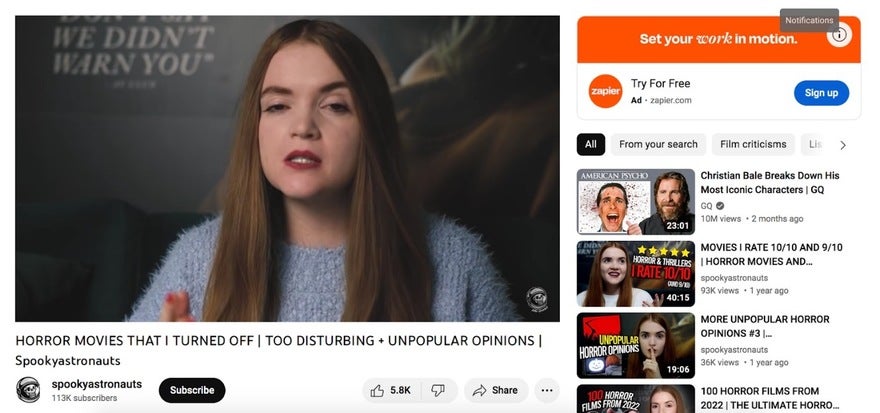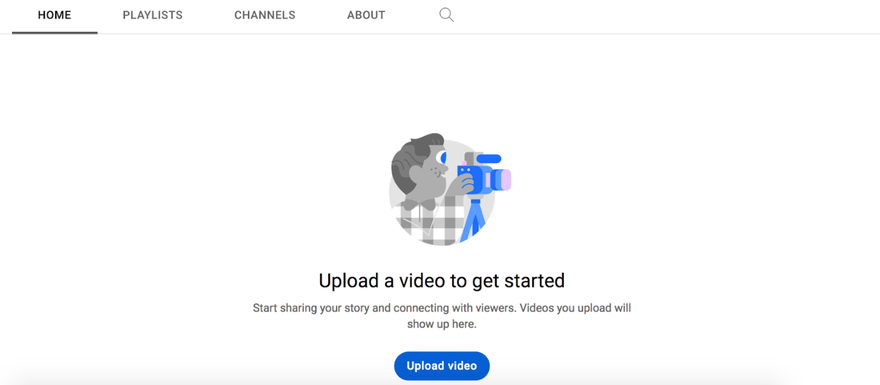How to Become a YouTuber – The Checklist
If you click to purchase a product or service based on our independent recommendations and impartial reviews, we may receive a commission. Learn more
Who doesn’t love a YouTube wormhole? Getting lost, often for hours, in a ceaseless chain of addictive video content.
YouTube is fun – but did you know it can also be a lucrative money spinner, too?
Yep. But how do you become a YouTuber, and start making – and marketing – money-making content on a regular basis?
Below, we’ve pulled together our top eight tips for how to become a YouTuber. From finding your niche and understanding your audience to promoting your channel and video optimisation, it’s all here. So read on – and enjoy!
What Is a YouTuber?
The term “YouTuber” refers, essentially, to anyone who creates and publishes content for YouTube, the popular social media and video sharing platform.
Technically, you don’t have to have a load of followers, or be making money off your videos, to be a YouTuber.
But for the purposes of this article, we’ll define “YouTuber” as someone who’s garnered enough interest and subscribers to begin monetizing their content. Who, whether it’s as a hobby, a side hustle, or a full-time job, are making a career on YouTube.
How Do YouTubers Make Money?
“Wait,” you ask… “did you say monetize?”
We did. So how do YouTubers make a living off the platform? Well, once YouTubers have amassed 1,000 subscribers, and 4,000 hours of watch time, they become eligible to join the YouTube partner program.
This program gives content creators the ability to access a range of advertising avenues: such as monetizing their videos through Google AdSense and affiliate marketing. YouTubers, when they get popular enough, also qualify as influencers – meaning they get paid to showcase specific products and services.
YouTubers also make money through fan funding (selling content through sites such as Patreon, for instance) and by leveraging their brand power to sell merchandise online. YouTubers can also make money by licensing their content to media organizations.
How to Become a YouTuber – The 2022 Checklist
Got designs on joining the hallowed halls of YouTube superstardom?
Success is just eight simple steps away…
#1: Find Your Niche
First up? Finding your niche.
Your niche refers to the particular industries and subject matter you’re going to be focusing on. Selecting – and sticking to – a specific niche is important, because it allows you to attract a relevant, engaged audience. It also means that, by providing consistency in the content you create, you’re more likely to retain those followers.
The more specific you can be here, the better. Food blogging is okay. Japanese food blogging is better. But blogging about a particular subset of Teriyaki sushi? That’s even better still! Start small, then expand – not the other way around.

When it comes to choosing a niche, start with what you’re passionate about. You’re going to be spending a lot of time planning, creating, and promoting this content. If it’s not something you have an innate love for, it’s going to be hard to put in all that work!
#2: Get to Know Your Audience
Now, it’s time to get acquainted with your audience. This involves developing an understanding of who, exactly, your videos are aiming to engage.
Knowing your audience will help you create more effective content. It’ll aid you in speaking to them in a more personal, direct way – appealing to their needs, solving their goals, and addressing their pain points with a targeted tone and messaging.
Ask yourself:
- Who’ll be watching my videos?
- How old are they?
- What gender do they identify as?
- Where might they work, or what kind of careers might they have?
- How will they be consuming my content – on a mobile device, or a desktop computer?
- Where – and when – will they be watching my videos?
- What are they hoping to gain by watching my content? Information? Entertainment? Enlightenment? All of the above?
If you’re struggling to think up answers to these questions, go straight to the source.
Reach out to potential customers with questionnaires, or assemble focus groups full of the kind of people you want to speak to. This kind of market research can give you a concrete understanding of your audience – and provide a vital, ongoing source of information as you build out a library of content.
#3: Check Out Your Competition
With a better idea of what your niche is, you’ll need to know who’s currently filling it – a.k.a your competitors.
Competitor research is a good place to start. So take to YouTube, and plug in some of the keywords that are most relevant to your industry. What channels are coming up? Which YouTubers’ faces are you seeing, over and over again, in your feed?
Chances are, these are the accounts and entertainers you’ll be coming up against when you launch your own channel. Create a spreadsheet, and start collating information about:
- How frequently your competitors are posting
- How many subscribers and video views they have
- How they design their channels and video thumbnails
- How they talk about themselves, and to their audience
- Which hashtags they’re using
And remember, competitor research isn’t simply about stealing your rivals’ ideas. It’s about looking for gaps, too. What aren’t they doing, that you could be? What are they doing that you could be doing 10 times as well? These are the questions that are going to unlock your competitive landscape – and help your channel make a splash.

#4: Create Your Channel
Here it is, the moment you’ve been waiting for – creating your channel!
To do so, sign into your YouTube account (if you don’t have one already, it’s very easy to set one up) and click your profile picture in the top right corner. It’ll pull up a drop-down menu that looks like this:

From here, select “Create a channel” and follow the on-screen prompts. After choosing a handle and picking your YouTube channel’s name, you’ll be able to customize your channel’s look and feel – and upload its first video!

#5: Create a Content Calendar
Next, it’s time to start creating your content – and, since you’ve done your research and selected a niche you’re passionate about, you’ll already be brimming with ideas.
But before you start bringing those ideas to life, you’ll need to organize them. And here’s where a content calendar comes in.
With a content calendar, you’ll plan what you’re going to be posting and when you’re going to be posting it. As well as how and when you’re going to amplify each video to your audience – be that via Instagram, Facebook, or your website.
How you put your content calendar together is up to you. It can be as basic as a spreadsheet with a few names and dates. Or, you can put a content calendar together with online tools such as monday.com, HubSpot, CoSchedule, or ClearVoice.

#6: Film and Upload Your Videos
It’s the fun part! Filming – then uploading – your videos.
Let’s start with the filming. What you film your videos on is up to you – smartphones have all but caught up to the standard of most professional cameras, and many YouTubers and photographers have built their brands around shooting exclusively on iPhones.
That said, you want your videos to look professional. So it’s worth at least investing in:
- A ring light to keep your face well lit
- A tripod to keep the camera steady as you film
- A microphone to enhance the volume and quality of your audio
As for the uploading part, simply hit that big blue “Upload video” button in the center of your new channel. You can then upload your video file, and go through the steps on-screen to publish it. Along the way, you’ll be asked to:
- Select a thumbnail (or, better yet, upload your own)
- Write a compelling video title and description
- Add hashtags

There’s a lot to think about here, and a lot to remember. But don’t worry – practice really does make perfect. And the more videos you upload, and the more you get the hang of the process’ finer points, the smoother it’ll all become.
#7: Promote Your Channel
Once you’ve released a few videos and your channel is starting to gain traction, it’s time to give it a little boost – and promote it far and wide.
How you do this will depend on your existing presence on the internet. If you have a website, place CTAs (calls-to-action) there to get people interested, or blog about your channel and its latest videos.
If it’s your social media presence that’s thriving, get the word out there. Cross-pollinate and promote across other video-based social platforms (TikTok comes to mind!) and across Facebook, Instagram, and Twitter. Heck – if it’s the right niche and audience, LinkedIn too.

#8: Respond to Comments
It’s not enough to simply release your videos into the world, then forget about them.
After all, you’re not simply creating content. You’re building an audience – and that means regularly engaging with them.
So like and respond to comments on your videos. Make videos celebrating new follower and view count milestones, and give your fans and subscribers hearty shoutouts. Share videos made by your fans that relate to your content, and encourage more of them to discuss and build off your videos on their own channels.
It’s good for YouTube’s algorithms. It’s even better for your brand!
How to Become a Successful YouTuber: Summary
Though we’ve done our best to get you there in eight steps, we should note that becoming a YouTuber doesn’t happen overnight. And, once it does happen, the work doesn’t stop.
Being a YouTuber is a constant (and constantly evolving) process that requires blood, sweat, and tears. As your channel gains pace, you can’t afford to take your foot off the gas. You need to keep producing content, continue engaging with your audience, and remain always on the lookout for new angles, ideas, and inspo.
It’s a long road, but you’ve got what it takes. Now hop to it!

Leave a comment